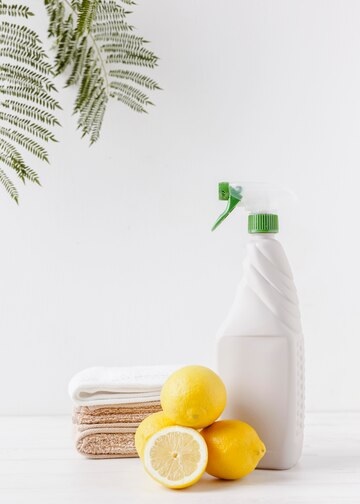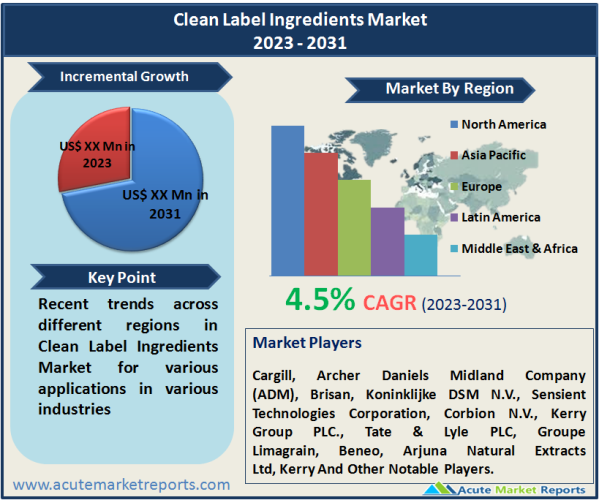
The clean label ingredients market is expected to grow at a CAGR of 4.5% during the forecast period of 2024 to 2032, driven by consumer demand for transparent and healthier food and beverage products. Clean-label ingredients are natural and minimally processed, free from artificial additives, and offer a cleaner and more sustainable choice for consumers. In 2023, the clean label ingredients market experienced robust revenue growth, driven by the factors mentioned above. However, from 2024 to 2032, the market is expected to witness even greater expansion, with revenues expected to increase substantially. As consumers continue to prioritize clean-label products, and as regulatory support and sustainability efforts intensify, the market is poised for significant growth in the forecast period. the clean label ingredients market is experiencing rapid growth due to increasing health consciousness, sustainability concerns, and regulatory support for clean labeling. While cost challenges may pose some restraints, the market's future looks promising. Segmentation by form and type highlights the versatility of clean-label ingredients, and geographic trends reveal a global commitment to clean labeling. Competitive trends underscore the importance of innovation, partnerships, sustainability, and global expansion in maintaining a competitive edge in the market.

Increasing Health Consciousness
One of the primary drivers of the clean label ingredients market is the increasing health consciousness among consumers. There is a growing awareness of the impact of diet on health, leading consumers to seek food and beverage products with cleaner and more natural ingredients. In 2023, this trend resulted in a surge in demand for clean-label ingredients, as consumers scrutinized product labels for artificial additives, preservatives, and synthetic flavors. This demand is expected to continue to rise from 2024 to 2032, as consumers prioritize products that contribute to their overall well-being.
Clean Label as a Sustainable Choice
The clean label movement is not just about health but also sustainability. Consumers are becoming more environmentally conscious, and they view clean-label ingredients as a more sustainable choice. Natural ingredients often have a smaller environmental footprint compared to their synthetic counterparts. For instance, the production of synthetic food colorings may involve chemical processes that release pollutants into the environment. In contrast, natural colors sourced from fruits and vegetables are perceived as a greener alternative. This sustainability aspect is expected to drive the adoption of clean-label ingredients further during the forecast period from 2024 to 2032.
Regulatory Support for Clean Labeling
Governments and regulatory bodies around the world are increasingly supporting clean labeling initiatives. They are implementing stricter regulations on food labeling, requiring manufacturers to disclose more information about ingredients and their sources. This transparency aligns with the clean label philosophy, encouraging manufacturers to reformulate their products using natural and recognizable ingredients. The implementation of regulations, such as the Food Safety Modernization Act (FSMA) in the United States and similar initiatives in other regions, has created a favorable environment for clean-label ingredient adoption. This regulatory support is expected to continue driving market growth throughout the forecast period.
Cost Challenges
One of the key restraints in the clean label ingredients market is the cost associated with sourcing and processing natural and clean-label ingredients. Natural ingredients often come at a higher cost compared to their synthetic counterparts. Additionally, the production and processing of clean-label ingredients may be more labor-intensive, requiring specialized farming practices or extraction methods. These factors can increase the overall production cost of food and beverage products containing clean-label ingredients. As a result, some consumers may face price barriers when choosing clean-label products. However, as the demand for clean-label ingredients continues to grow, economies of scale and improved sourcing practices are expected to alleviate some of these cost challenges over time.
Market by Form: Powder Segment to Dominate the Market
In 2023, clean-label ingredients in powder form generated the highest revenue, primarily due to their versatility in various applications, including baking, beverages, and supplements. However, during the forecast period from 2024 to 2032, the "Liquid" form is expected to exhibit the highest CAGR. Liquid clean-label ingredients are gaining popularity in products like dairy alternatives, salad dressings, and beverages due to their ease of incorporation and sensory appeal.
Market by Type: Fruit and vegetable Ingredients Dominate the Market
In 2023, fruit and vegetable ingredients accounted for the highest revenue share in the clean-label ingredients market, as they are widely used for natural flavor enhancement, coloring, and nutritional enrichment. However, from 2024 to 2032, "Natural Flavors" are expected to experience the highest CAGR, driven by the demand for clean-label alternatives to artificial flavorings.
North America Remains as the Global Leader
In 2023, North America held the highest revenue percentage in the clean label ingredients market, driven by the health-conscious consumer base and regulatory support for clean labeling. However, the Asia-Pacific region is expected to exhibit the highest CAGR from 2024 to 2032. This growth is fueled by the rising middle-class population, increasing disposable income, and a growing preference for clean-label products in countries like China and India. Additionally, European markets are expected to continue their steady growth due to the region's long-standing commitment to clean-label ingredients and sustainability.
Investment in R&D to Enhance the Market Shares of Top Competitors
The clean label ingredients market features several key players that are driving the industry's growth through innovation and strategic initiatives. Some of the top players in the market include Cargill, Archer Daniels Midland Company (ADM), Brisan, Koninklijke DSM N.V., Sensient Technologies Corporation, Corbion N.V., Kerry Group PLC., Tate & Lyle PLC, Groupe Limagrain, Beneo, Arjuna Natural Extracts Ltd, Kerry and Ingredion Incorporated. These companies have adopted various strategies to maintain their competitive positions and cater to the evolving demands of consumers. Leading companies are continuously investing in research and development to create new clean label ingredients and improve existing ones. For example, Cargill has introduced a range of clean label starches and sweeteners, meeting consumer demand for natural alternatives in food and beverage products. This focus on innovation allows companies to expand their product portfolios and stay ahead of market trends.
Historical & Forecast Period
This study report represents analysis of each segment from 2022 to 2032 considering 2023 as the base year. Compounded Annual Growth Rate (CAGR) for each of the respective segments estimated for the forecast period of 2024 to 2032.
The current report comprises of quantitative market estimations for each micro market for every geographical region and qualitative market analysis such as micro and macro environment analysis, market trends, competitive intelligence, segment analysis, porters five force model, top winning strategies, top investment markets, emerging trends and technological analysis, case studies, strategic conclusions and recommendations and other key market insights.
Research Methodology
The complete research study was conducted in three phases, namely: secondary research, primary research, and expert panel review. key data point that enables the estimation of Clean Label Ingredients market are as follows:
Market forecast was performed through proprietary software that analyzes various qualitative and quantitative factors. Growth rate and CAGR were estimated through intensive secondary and primary research. Data triangulation across various data points provides accuracy across various analyzed market segments in the report. Application of both top down and bottom-up approach for validation of market estimation assures logical, methodical and mathematical consistency of the quantitative data.
| ATTRIBUTE | DETAILS |
|---|---|
| Research Period | 2022-2032 |
| Base Year | 2023 |
| Forecast Period | 2024-2032 |
| Historical Year | 2022 |
| Unit | USD Million |
| Segmentation | |
Form
| |
Type
| |
Application
| |
Distribution Channel
| |
|
Region Segment (2022-2032; US$ Million)
|
Key questions answered in this report